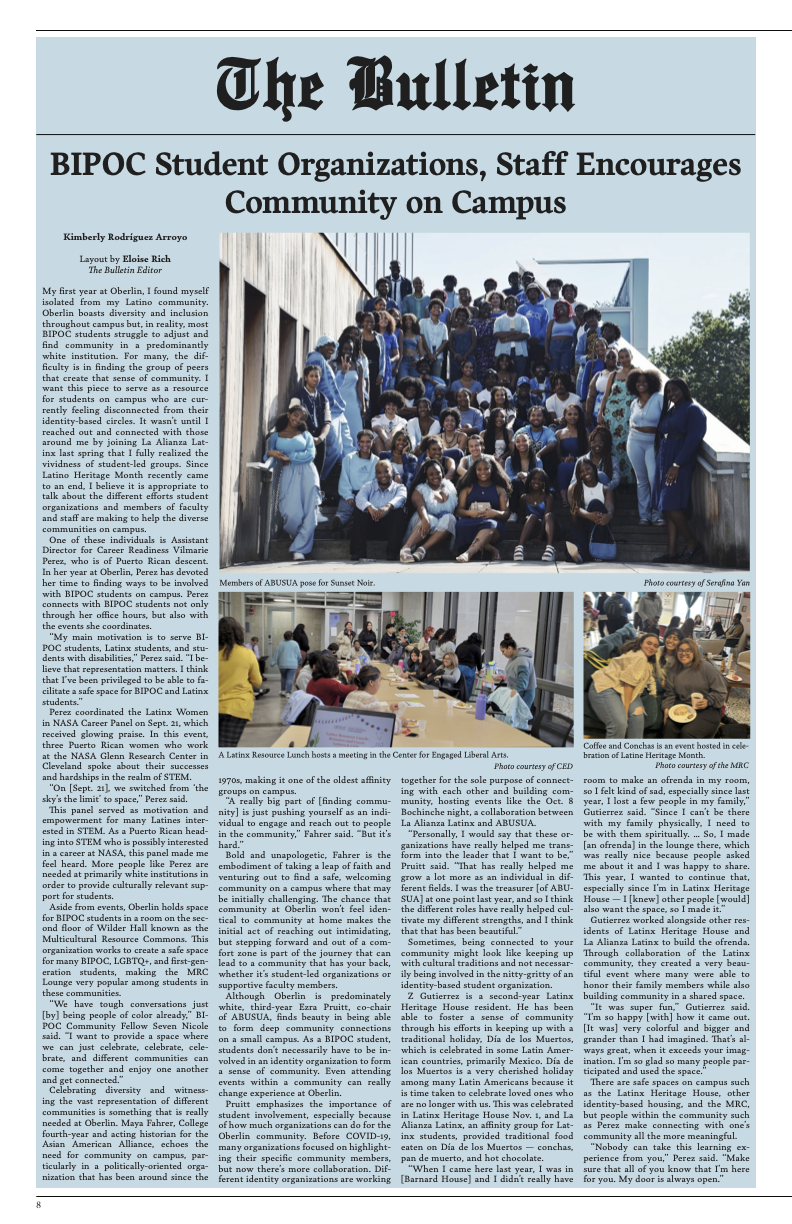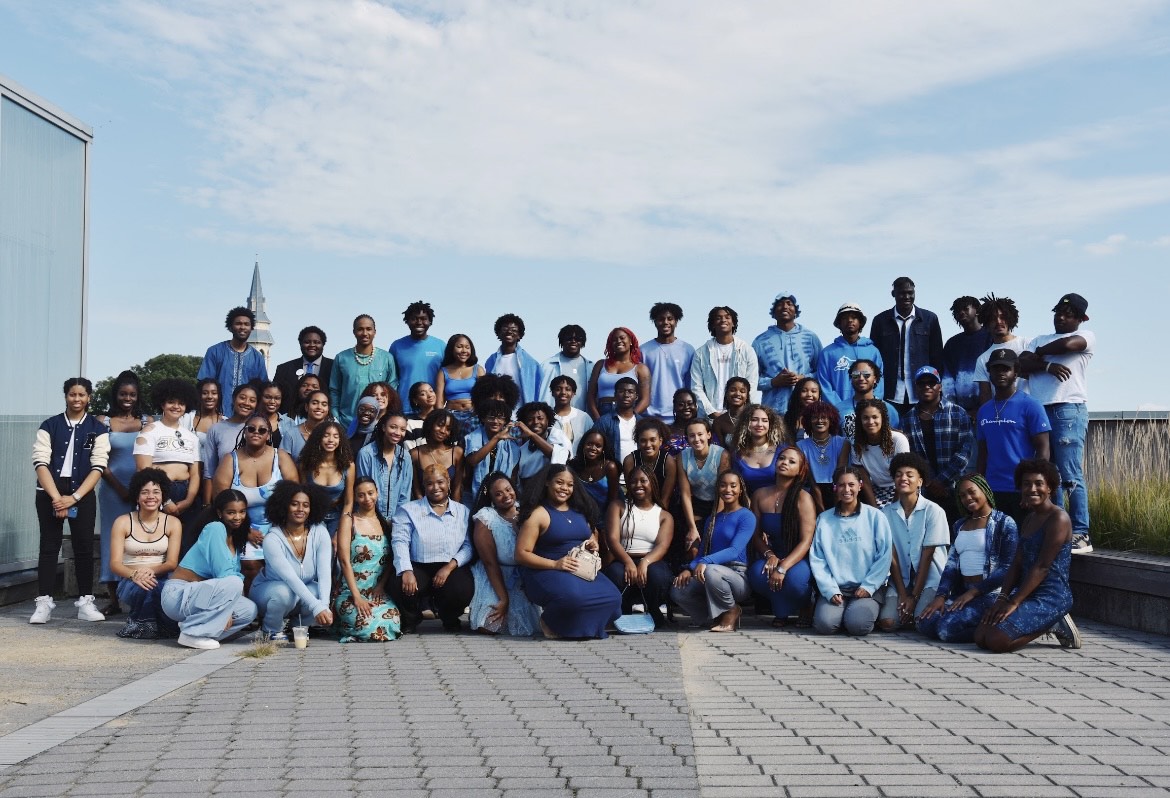My first year at Oberlin, I found myself isolated from my Latino community. Oberlin boasts diversity and inclusion throughout campus but, in reality, most BIPOC students struggle to adjust and find community in a predominantly white institution. For many, the difficulty is in finding the group of peers that create that sense of community. I want this piece to serve as a resource for students on campus who are currently feeling disconnected from their identity-based circles. It wasn’t until I reached out and connected with those around me by joining La Alianza Latinx last spring that I fully realized the vividness of student-led groups. Since Latino Heritage Month recently came to an end, I believe it is appropriate to talk about the different efforts student organizations and members of faculty and staff are making to help the diverse communities on campus.
One of these individuals is Assistant Director for Career Readiness Vilmarie Perez, who is of Puerto Rican descent. In her year at Oberlin, Perez has devoted her time to finding ways to be involved with BIPOC students on campus. Perez connects with BIPOC students not only through her office hours, but also with the events she coordinates.
“My main motivation is to serve BIPOC students, Latinx students, and students with disabilities,” Perez said. “I believe that representation matters. I think that I’ve been privileged to be able to facilitate a safe space for BIPOC and Latinx students.”
Perez coordinated the Latinx Women in NASA Career Panel on Sept. 21, which received glowing praise. In this event, three Puerto Rican women who work at the NASA Glenn Research Center in Cleveland spoke about their successes and hardships in the realm of STEM.
“On [Sept. 21], we switched from ‘the sky’s the limit’ to space,” Perez said.
This panel served as motivation and empowerment for many Latines interested in STEM. As a Puerto Rican heading into STEM who is possibly interested in a career at NASA, this panel made me feel heard. More people like Perez are needed at primarily white institutions in order to provide culturally relevant support for students.
Aside from events, Oberlin holds space for BIPOC students in a room on the second floor of Wilder Hall known as the Multicultural Resource Commons. This organization works to create a safe space for many BIPOC, LGBTQ+, and first-generation students, making the MRC Lounge very popular among students in these communities.
“We have tough conversations just [by] being people of color already,” BIPOC Community Fellow Seven Nicole said. “I want to provide a space where we can just celebrate, celebrate, celebrate, and different communities can come together and enjoy one another and get connected.”
Celebrating diversity and witnessing the vast representation of different communities is something that is really needed at Oberlin. Maya Fahrer, College fourth-year and acting historian for the Asian American Alliance, echoes the need for community on campus, particularly in a politically-oriented organization that has been around since the 1970s, making it one of the oldest affinity groups on campus.
“A really big part of [finding community] is just pushing yourself as an individual to engage and reach out to people in the community,” Fahrer said. “But it’s hard.”
Bold and unapologetic, Fahrer is the embodiment of taking a leap of faith and venturing out to find a safe, welcoming community on a campus where that may be initially challenging. The chance that community at Oberlin won’t feel identical to community at home makes the initial act of reaching out intimidating, but stepping forward and out of a comfort zone is part of the journey that can lead to a community that has your back, whether it’s student-led organizations or supportive faculty members.
Although Oberlin is predominately white, third-year Ezra Pruitt, co-chair of ABUSUA, finds beauty in being able to form deep community connections on a small campus. As a BIPOC student, students don’t necessarily have to be involved in an identity organization to form a sense of community. Even attending events within a community can really change experience at Oberlin.
Pruitt emphasizes the importance of student involvement, especially because of how much organizations can do for the Oberlin community. Before COVID-19, many organizations focused on highlighting their specific community members, but now there’s more collaboration. Different identity organizations are working together for the sole purpose of connecting with each other and building community, hosting events like the Oct. 8 Bochinche night, a collaboration between La Alianza Latinx and ABUSUA.
“Personally, I would say that these organizations have really helped me transform into the leader that I want to be,” Pruitt said. “That has really helped me grow a lot more as an individual in different fields. I was the treasurer [of ABUSUA] at one point last year, and so I think the different roles have really helped cultivate my different strengths, and I think that that has been beautiful.”
Sometimes, being connected to your community might look like keeping up with cultural traditions and not necessarily being involved in the nitty-gritty of an identity-based student organization.
Z Gutierrez is a second-year Latinx Heritage House resident. He has been able to foster a sense of community through his efforts in keeping up with a traditional holiday, Día de los Muertos, which is celebrated in some Latin American countries, primarily Mexico. Día de los Muertos is a very cherished holiday among many Latin Americans because it is time taken to celebrate loved ones who are no longer with us. This was celebrated in Latinx Heritage House Nov. 1, and La Alianza Latinx, an affinity group for Latinx students, provided traditional food eaten on Día de los Muertos — conchas, pan de muerto, and hot chocolate.
“When I came here last year, I was in [Barnard House] and I didn’t really have room to make an ofrenda in my room, so I felt kind of sad, especially since last year, I lost a few people in my family,” Gutierrez said. “Since I can’t be there with my family physically, I need to be with them spiritually. … So, I made [an ofrenda] in the lounge there, which was really nice because people asked me about it and I was happy to share. This year, I wanted to continue that, especially since I’m in Latinx Heritage House — I [knew] other people [would] also want the space, so I made it.”
Gutierrez worked alongside other residents of Latinx Heritage House and La Alianza Latinx to build the ofrenda. Through collaboration of the Latinx community, they created a very beautiful event where many were able to honor their family members while also building community in a shared space.
“It was super fun,” Gutierrez said. “I’m so happy [with] how it came out. [It was] very colorful and bigger and grander than I had imagined. That’s always great, when it exceeds your imagination. I’m so glad so many people participated and used the space.”
There are safe spaces on campus such as the Latinx Heritage House, other identity-based housing, and the MRC, but people within the community such as Perez make connecting with one’s community all the more meaningful.
“Nobody can take this learning experience from you,” Perez said. “Make sure that all of you know that I’m here for you. My door is always open.”



